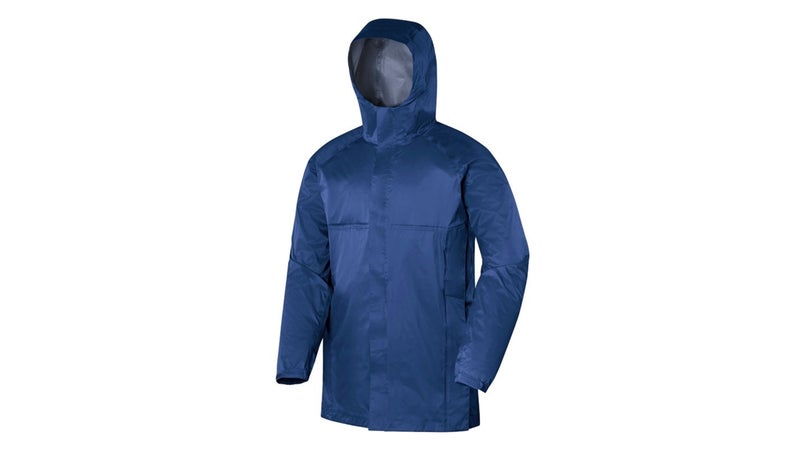“There is no waterproof breathable fabric on the market that can dissipate enough moisturize to keep you dry while hiking hard with a backpack on,” said Sierra Designs' Vice President Michael Glavin in . Glavin had filmed the video to help sell the company’s new Ultralight Trench and talk about how, in his mind, waterproof-breathable fabrics (the hard-shell material that Gore-Tex and others make) don’t live up to the marketing hype. “What sets these jackets apart,” he said, gesturing toward the Trench, “is active venting.”
In real-people terms, that means designing the jacket in such a way that it’s easy to allow fresh air in and hot, sweat-laden air out. Sierra Designs achieved this with its Ultralight Trench by cutting a massive flap into the bottom half of the jacket, so the user could flip it up and over a hipbelt if she got too hot. It paired that design with permanently open underarm vents and two chest pockets that cross-ventilated the torso.
It was a great idea that I found to work exceptionally well. I’d put my pack on over the jacket and run the waist belt under the dangling front panel. Because the waist belt wouldn't cinch material against my stomach, air would circulate upward through the jacket and out the pit vents as I walked. Brilliant.

Alas, earlier this year, Sierra Designs discontinued both the Ultralight Trench and its heavier Pack Trench relative, with no replacement in mind. So now we’re back to ponchos and pit zips on otherwise-sealed hard-shell jackets. And that’s a real pity.
You see, as great as hard shells are, none of the designs currently on the market actually breathes all that well. They’re made out of fabric with a porous membrane, with each pore 20,000 times smaller than a water droplet. The idea is that it keeps rain out, but also vents sweat-vapor, thus preventing you from feeling like you’re wearing a plastic garbage bag. It performs well in laboratory tests and certain cool weather conditions, but anyone who’s ever actually exercised with a hard shell on—especially in humid places—knows that it’s easy to overwhelm the material.
I acknowledge that hard shells are useful in wet and ultra-windy conditions, and I have perfected a careful ritual of zipping and unzipping it so I won't sweat out a monsoon while wearing one. But as soon as the shell’s not needed, I ditch it for a soft shell or a wind shirt.
Air needs both an entrance and an exit to circulate. Open one window in your apartment or car, and you get a bit of a breeze. Open a second window farther away, and air circulates into and out of the space much more freely, allowing a more significant breeze. Jackets are similar. Normal hard shells—with simple pit zips—don’t breathe all that well, as a backpack's hip belt chokes off circulation at the waist and leaves only a limited upper portion of the jacket to vent.
The Pack Trench and Ultralight Trench fixed this problem with their clever design. Now, they weren’t the best for alpine climbing, where the always-open pit zips would let in the strong winds that run unimpeded at high altitudes. But for day hiking, overnight backpacking, biking, and cragging, the always-venting hard shell worked really well. Even for winter hiking, where trees and terrain break up the wind, hikers spend a lot of time trudging with jackets unzipped and hoping for more ventilation in wet snow, when temperatures fluctuate around 30 or so degrees.
Sierra Designs decided to discontinue the jackets largely because of slow sales, says Adrian Person, Sierra Designs' former manager for the Rockies Territory who now works for Kelty. “The mechanical venting did actually work very well, but unfortunately they had no other distinguishing features or looks to make them stand out against larger brands. A couple more-technical dealers actually had really good success with this product, but it simply wasn't enough.”
Hikers on and liked it, as did hiking blogger Andrew Skurka, who joined Sierra Designs as a consultant in early 2015. But they represent fringe communities, made up of people who count ounces and choose to spend free time discussing gear on internet forums. The average person shops the rack at REI and might consult a mainstream review site, and there the Trenches were a rare sight. Outdoorgearlab.com never included one in its annual gear tests for men’s or women’s hard shells, and both models were absent from magazine coverage and yearly round-ups.
Yet the always-venting hard shell remains a worthy idea, even as the last Trench jackets sit in . This is your last chance to get one of these jackets—unless Sierra Designs' new team decides to bring the idea back. (Hint, hint.)
Buy Now While You Still Can:


